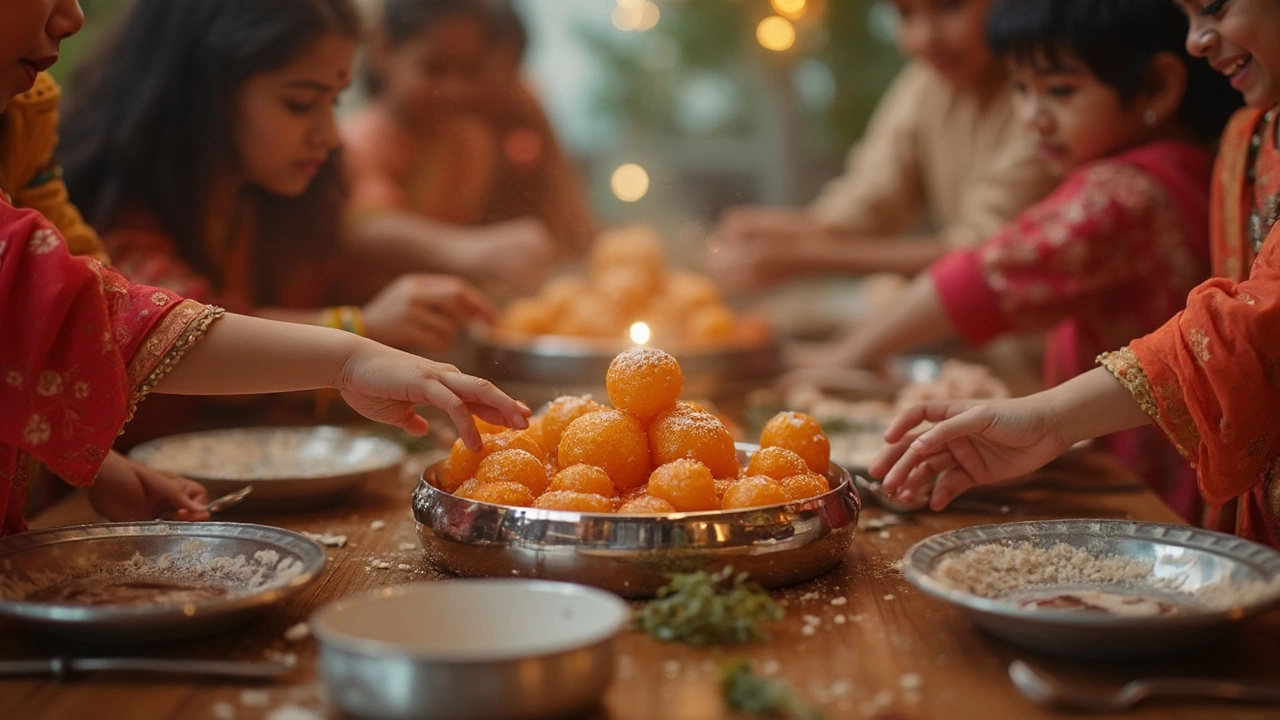15 May 2025
- 0 Comments
Nothing gets people excited at an Indian party like a tray of fresh Gulab Jamun. If you haven't tried these, imagine bite-sized balls that are soft, sweet, and soaked in syrup, melting in your mouth every time. Even my picky kid, Ivy, can't resist snatching an extra one when she thinks I’m not looking. And it's not just my household—step into any Indian wedding or festival and you’ll see Gulab Jamun disappear before anything else.
There’s something almost magical about them. They’re easy to spot in Indian sweet shops, always sitting right up front in neat little piles. That’s because they hit the perfect note—sweet, rich but not overwhelming, with a hint of rose or cardamom that keeps you coming back for more. No wonder so many people crave them for every celebration and even regular weeknights.
- Why Gulab Jamun Tops the List
- What Makes Gulab Jamun Irresistible
- A Quick How-To for Perfect Gulab Jamun
- Fun Facts and Variations
- Tips for Newbies and Busy Parents
Why Gulab Jamun Tops the List
You can’t talk about Indian desserts without mentioning Gulab Jamun. It’s the national favorite. The proof? In a 2023 survey run by Swiggy, one of the biggest food delivery apps in India, Gulab Jamun was the top-ordered sweet during festivals, birthdays, and family get-togethers—racking up millions of orders just during Diwali week. No other sweet even came close.
What puts Gulab Jamun on a pedestal? For starters, it fits every occasion. Wedding? Check. Birthday? Of course. Just got a promotion? Absolutely. Families trust it to please everyone, from toddlers who can’t handle spicy food to grandparents wanting something classic.
- You find it everywhere: street stalls, high-end restaurants, airports, casual office parties.
- No special utensils needed—dunk it in syrup and eat with a spoon. Super easy.
- It has that taste nostalgia: most people in India grew up with Gulab Jamun at celebrations.
Plus, it’s the ‘safe’ dessert to order or bring, because hardly anyone dislikes it. It’s dairy-based (usually made with khoya or milk powder), which gives it a soft, creamy texture and a rich taste. Yet, it’s not so sugary that it feels heavy—making people reach for a second or third serving.
| Year | Gulab Jamun Festival Orders (Swiggy) | Top Competing Sweet |
|---|---|---|
| 2022 | 3.2 million | Rasgulla (2 million) |
| 2023 | 3.8 million | Jalebi (2.4 million) |
The simplicity and comfort of Gulab Jamun make it almost universal. Even folks outside India are catching on—restaurants in London, New York, and Sydney keep it on their dessert menus for good reason. And yes, it’s a hit with Instagram foodies too, thanks to drool-worthy syrup shots.
What Makes Gulab Jamun Irresistible
If you ask any Indian family what sweet shows up most at gatherings, the answer is “Gulab Jamun”—and honestly, it's tough to argue. There’s just something about its melt-in-your-mouth texture and the way the sugar syrup seeps all the way through. When you bite into one, it’s soft but not mushy, and you get this mix of creamy and just-sweet-enough punch from the syrup. People always remark how Gulab Jamun brings a burst of nostalgia for childhood or family celebrations.
What makes it so popular? It’s partly how simple but rich the ingredient list is. Traditional versions use milk solids called khoya (think of it as milk thickened until almost solid), flour, a little baking soda, and cardamom. The dough is rolled into small balls and deep-fried on a slow flame—that's key for keeping them soft inside. Then those golden balls soak in warm sugar syrup flavored lightly with rose water or saffron. No fancy gadgets, just basic stuff you probably have at home with a few “treat-yourself” extras.
- Texture: Spongy inside, syrupy outside—totally unique in the world of sweets.
- Flavor: Balanced—never cloying. The magic is in the subtle hint of cardamom or rose.
- Universal: Kids, teenagers, adults, and even grandparents love them.
- Festive: They're everywhere—from small home gatherings to huge Indian weddings.
If you want hard numbers, check out this fun stat. In a 2023 online poll from an Indian cooking forum, Gulab Jamun scored the highest with nearly 34% of votes for the “must-have” sweet at festive meals, beating other classics like rasgulla and jalebi.
| Sweet Name | Popularity Vote (%) |
|---|---|
| Gulab Jamun | 34 |
| Rasgulla | 22 |
| Jalebi | 18 |
| Ladoo | 15 |
| Barfi | 11 |
Even people who don’t typically go for sweets get hooked, because Gulab Jamun hits that just-right spot—comforting, familiar, and special all at once. And unlike a lot of desserts, you don’t need to use a fork and knife. Grab one, pop it in whole or nibble away. It’s no wonder these plump little spheres have stuck around as a star of Indian dessert tables.

A Quick How-To for Perfect Gulab Jamun
Making Gulab Jamun at home looks tricky, but you can nail it if you know a few key steps. Most Indian kitchens use khoya (milk solids), but outside India, people use milk powder or ready-mix. Don’t worry, they all work if you follow the basics.
Here’s a dead-simple step-by-step for making soft and juicy Gulab Jamun:
- Mix the dough: Take 1 cup milk powder, 2 tbsp ghee, 2 tbsp all-purpose flour, and a pinch of baking soda. Mix lightly, then add 1/4 cup milk a little at a time to make a soft dough—don’t knead too hard or your balls turn rubbery.
- Shape into balls: Make small, smooth balls about the size of a walnut. If you see cracks, dab a bit of ghee and roll again.
- Prepare the syrup: In a pan, mix 2 cups sugar, 2 cups water, and a few crushed cardamom pods. Boil till slightly sticky (it shouldn’t be thick like honey). Optional: add a dash of rose water or saffron.
- Frying time: On medium-low heat, fry the balls in oil or ghee until they turn deep golden brown. Keep the heat low so the insides cook through—rush this and you’ll get hard centers.
- Soak and serve: Drain extra oil and dunk those fried balls straight into hot syrup. Let them soak at least 30 minutes; they’ll fluff up and get juicy. Eat warm or cold—either way, they’re irresistible.
Got family coming over? Here’s a cheat sheet to help you get the proportions right fast:
| Ingredient | Amount (serves ~12) |
|---|---|
| Milk powder | 1 cup |
| All-purpose flour (maida) | 2 tbsp |
| Ghee | 2 tbsp |
| Baking soda | 1/8 tsp |
| Milk | 1/4 cup (or as needed) |
| Sugar | 2 cups |
| Water | 2 cups |
| Cardamom (crushed) | 3-4 pods |
Here’s a quick tip: Don’t overcrowd the pan while frying. If the oil is bubbling like crazy or the balls are cracking, turn down the heat and wait a few seconds before adding more. Burnt outsides with raw middles is the number one rookie mistake!
Fun Facts and Variations
Gulab Jamun is basically the Beyoncé of Indian sweets—always in the limelight, always stealing the thunder. Here’s something cool: the name literally means “rose berry.” That’s because the sugar syrup is usually flavored with rose water, giving it a light floral taste. The traditional recipe uses khoya (reduced milk solids), but hey, if you’re low on time, milk powder actually works just as well and is super popular outside India.
Did you know Gulab Jamun actually traces its roots back to Persia? Historians say Persians introduced something similar ages ago, and the recipe evolved in Indian kitchens to what we now fight over at family get-togethers.
- Color counts: The original is golden-brown from slow frying. Some folks add a pinch of saffron for a deeper hue. Don’t be surprised to see bright orange or almost black (Kala Jamun) versions at sweet shops—the taste gets bolder but the vibe stays the same.
- Surprising add-ins: While the classic syrup is rose and cardamom, some variants swap in saffron or even stuff the middle with nuts for crunch. Pistachios or almonds inside really shake things up for special occasions.
- Festivals and more: No Indian Diwali, Holi, or Eid is complete without them. They’re a must at birthday parties, too. On social media, it’s pretty common to see people in the UK and US try quirky hacks like Gulab Jamun cheesecakes or even ice cream toppings.
One last thing—Gulab Jamun isn't only about tradition. It’s one sweet with no borders, easy hacks, and lots of ways to make it your own. If you mess up and they fall apart? No big deal—just crumble them into your ice cream and call it a new recipe. That’s how most family favorites are born, anyway!

Tips for Newbies and Busy Parents
Making Gulab Jamun from scratch sounds intense, but it’s actually pretty doable—even if you have wild kids running around or a hundred things on your plate. Here’s how to get it right with way less stress than you think.
- Go for ready-mix packets: If you’re short on time, the pre-mixed boxes from brands like Haldiram or Gits are super reliable. You just add milk, roll, fry, and soak—no need to fuss over finding every ingredient.
- Don’t rush the syrup: The sugar syrup needs to simmer for at least 8-10 minutes until slightly sticky. Throw in a cardamom pod or tiny splash of rose water to get that authentic touch.
- Low-heat frying works best: Keep your oil at medium-low. If it’s too hot, the balls get brown outside but raw inside. Test with a small bit—if it rises steadily, you’re good.
- Use milk powder if khoya feels like a chore: Lots of people swap in milk powder plus a bit of cream and plain flour. No flavor lost, but it’s much quicker.
- Let them soak: Don’t rush them from syrup to plate. Try for a 30-minute soak so they’re juicy all the way through. If you’re prepping for a party, make them a day ahead—they actually taste better!
Gulab Jamun even wins on the numbers: check this out—according to recent polls from Indian food delivery giants, they’re the top-ordered sweet nearly every festival and, surprisingly, get reordered almost 26% more often than other desserts.
| Sweet | Festival Season Orders (India, 2024) |
|---|---|
| Gulab Jamun | 2,100,000 |
| Rasgulla | 1,540,000 |
| Jalebi | 1,300,000 |
| Ladoo | 1,020,000 |
Still worried about mess? Line your counter with newspaper and rope your kids in for rolling dough balls. A little chaos is normal—and totally worth it for the bragging rights and that sweet reward at the end.
